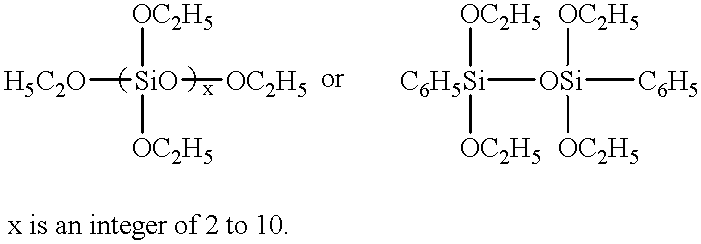Flame retardant resin compositions
a technology of flame retardant resin and composition, which is applied in the direction of transportation and packaging, tyre parts, special tyres, etc., can solve the problems of high cost of silicone resins having special organic functional radicals, insufficient flame retardant effect to compensate for increased cost, and insufficient flame retardant
- Summary
- Abstract
- Description
- Claims
- Application Information
AI Technical Summary
Benefits of technology
Problems solved by technology
Method used
Image
Examples
preparation example 1
A 1-liter flask equipped with a stirrer, condenser and thermometer was charged with 211 g (1 mol) of phenyltrichlorosilane and 143 g of toluene and heated to an internal temperature of 40.degree. C. in an oil bath. A dropping funnel was charged with 64 g (2 mol) of methanol, which was added dropwise to the flask over one hour with stirring. Alkoxylation reaction was proceeded while removing out of the system hydrogen chloride gas evolving during the reaction. At the end of dropwise addition, stirring was continued at the internal temperature of 40.degree. C. for a further one hour for ripening. The dropping funnel was then charged with 12 g (0.7 mol) of water, which was added dropwise to the flask over one hour with stirring. Hydrolytic condensation reaction was proceeded while removing out of the system hydrogen chloride gas evolving during the reaction. At the end of dropwise addition, stirring was continued at the internal temperature of 40.degree. C. for a further one hour for r...
preparation example 2
The procedure of Preparation Example 1 was repeated except that in the alkoxylation step, the 1-liter flask was charged with 159 g (0.75 mol) of phenyltrichlorosilane, 37 g (0.25 mol) of methyltrichlorosilane, and 143 g of toluene, and the dropping funnel was charged with 48 g (1.5 mol) of methanol, and in the subsequent hydrolytic condensation step, the dropping funnel was charged with 18 g (1 mol) of water. There was obtained 120 g of a liquid methoxy-bearing organosiloxane.
The resulting organosiloxane is of
Ph.sub.0.75 (CH.sub.3).sub.0.25 Si(OCH.sub.3).sub.1.0 (OH).sub.0.17 O.sub.1.83 / 2,
when represented by the average compositional formula:
R.sup.1.sub.m R.sup.2.sub.n Si(OR.sup.3).sub.p (OH).sub.q O.sub.(4-m-n-p-q) / 2
wherein m=0.75, n=0.25, n / (m+n)=0.25, the organic substituents attached to silicon atoms through Si--C bonds are 75 mol % phenyl and 25 mol % methyl, p=1.0, R.sup.3 = methyl, q=0.17, and trifunctional siloxane units are contained 100 mol %. The organosiloxane appeared t...
preparation example 3
The procedure of Preparation Example 1 was repeated except that in the alkoxylation step, the 1-liter flask was charged with 159 g (0.75 mol) of phenyltrichlorosilane, 37 g (0.25 mol) of vinyltrichlorosilane, and 143 g of toluene, and the dropping funnel was charged with 48 g (1.5 mol) of methanol, and in the subsequent hydrolytic condensation step, the dropping funnel was charged with 17 g (0.9 mol) of water. There was obtained 120 g of a liquid methoxy-bearing organosiloxane.
The resulting organosiloxane is of
Ph.sub.0.7 Vi.sub.0.25 Si(OCH.sub.3).sub.1.0 (OH).sub.0.17 O.sub.1.83 / 2,
when represented by the average compositional formula:
R.sup.1.sub.m R.sup.2.sub.n Si(OR.sup.3).sub.p (OH).sub.q O.sub.(4-m-n-p-q) / 2
wherein m=0.75, n=0.25, n / (m+n)=0.25, the organic substituents attached to silicon atoms through Si--C bonds are 75 mol % phenyl and 25 mol % vinyl, p=1.0, R.sup.3 =methyl, q=0.17, and trifunctional siloxane units are contained 100 mol %. The organosiloxane appeared to be a col...
PUM
| Property | Measurement | Unit |
|---|---|---|
| Percent by mass | aaaaa | aaaaa |
| Percent by mass | aaaaa | aaaaa |
| Weight | aaaaa | aaaaa |
Abstract
Description
Claims
Application Information
 Login to View More
Login to View More - R&D
- Intellectual Property
- Life Sciences
- Materials
- Tech Scout
- Unparalleled Data Quality
- Higher Quality Content
- 60% Fewer Hallucinations
Browse by: Latest US Patents, China's latest patents, Technical Efficacy Thesaurus, Application Domain, Technology Topic, Popular Technical Reports.
© 2025 PatSnap. All rights reserved.Legal|Privacy policy|Modern Slavery Act Transparency Statement|Sitemap|About US| Contact US: help@patsnap.com


